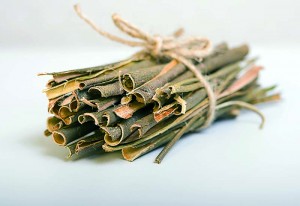In order to gain a better orientation to the world of herbs, it’s useful to get familiar with the chemicals they contain. What are they good for, and how can they help us? In this new series, we will gradually reveal to you the secrets of most known chemicals found in herbs.
Glycosides are common all over the plant kingdom. They are a mostly colorless substance dissolvable in alcohol and water. They represent the energetic component of plants and are made of carbon, hydrogen, and oxygen and sometimes also nitrogen, potassium, and sulfur.
Glycosides are natural organic compounds comprising sugary and non-sugary groups. The sugary group is made of monosaccharides (simple sugars – glucose, rhamnose, galactose, xylose…) and is known as glycone, and the non-sugary group is called aglycone or genin. Some glycosides are unique for certain families of plants, and some families can even contain various types of glycosides. The production of glycosides has also a detoxifying effect on the plant: when lipophilic (dissolvable in fats, oils, and lipids) toxins get bound to sugars, they become dissolvable in water and therefore transportable. They can also function as sugar storage agents.
Glycosides are the largest group of secondary metabolites and are useful in therapy, but some are toxic.![]() The especially glycoside-rich plants are members of the dogbane family (Apocynaceae), peacock flower family (Caesalpiniaceae), bindweed family (Convolvulaceae), legume family (Fabaceae), Mimosaceae family, and the buttercup family (Ranunculaceae). Glycosides can be found in various parts of the plant (bulb, stem, leaves, seeds ,etc.).
The especially glycoside-rich plants are members of the dogbane family (Apocynaceae), peacock flower family (Caesalpiniaceae), bindweed family (Convolvulaceae), legume family (Fabaceae), Mimosaceae family, and the buttercup family (Ranunculaceae). Glycosides can be found in various parts of the plant (bulb, stem, leaves, seeds ,etc.).
Phenolic glycosides and lignans
White willow (Salix alba)
 This tree grows mainly in temperate and subarctic climates in the northern hemisphere. Its dried bark gets picked in early spring and is used to treat rheumatism. It contains about 10% phenolic glycosides, mainly salicin. Salicin gets split further into saligenin, which oxidizes into salicylic acid.
This tree grows mainly in temperate and subarctic climates in the northern hemisphere. Its dried bark gets picked in early spring and is used to treat rheumatism. It contains about 10% phenolic glycosides, mainly salicin. Salicin gets split further into saligenin, which oxidizes into salicylic acid.
Snowbell (Styrax tonkinense)
Snowbell is a tree originally found in Southeast Asia and east India. It is grown mainly in Thailand, Vietnam, and Laos.

